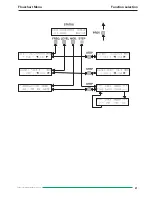
10
Subject to change without notice
The return to the previous menu is possible by pressing the
«PREV.» key (3).
After selecting «Fmod» option, we get (from AM MENU)
The frequency of internal modulation signal may be directly
change by numeric keypad (11) or modified by the digital rotary
(10) or one of the four context sensitive keys (5). The return
to the previous menu is possible by pressing the «PREV.» key
(3).
The frequency range is:
• 10Hz to 100kHz Sine by step 10Hz ( 40kHz in AM).
• 10Hz to 20kHz Tri,Sqr,+Rp,-Rp by step 10Hz
(Sqr in FM and PM).
The modulation is turned on by pressing the context sensitive
key below the string «off»; one time for turning the internal
source on and a second time for turning the external source
on. The active source is pointed out by the triangle beside the
option.The announciator of the MOD.OUT. is lighting.
More generaly, the modulation is turned off by pressing the
key corresponding to the active source one or two time
depending on witch one is in progress ( OffIntExtOff). The
return to the previous menu is possible by pressing the
«PREV.» key (3). In external AM, the only one possible option
is to change the depth (see corresponding paragraph).
The frequency of the external modulation must be in a range:
• 10Hz to 50kHz in AM.
In external FM or PM several cases are possible depending on
the carrier frequency.
For carrier frequencies < 16MHz, we get (for FM):
A new value of this level can be entered from the data keypad
(11) or modified by the digital rotary (10) or one of the four
context sensitive keys (5). For more details, refer to the
paragraph « setting parameters».
The level range is:
• -127dBm to +13dBm without amplitude modulation.
• -127dBm to +7dBm with amplitude modulation.
• The resolution is 0.1dBm
The level displayed is specified for a loading impedance of 50.
The choice of the unit is made by the keys (11)» dBm/mV/µV
«. For the volt unit the instrument performs a three digits
conversion according to the properest range (nV/µV/nV).
Caution:
When the AM modulation is on, the instrument auto-
matically set the limit to +7dBm, for avoiding to exceed
the dynamic of the ouput amplifier.
Selecting modulations
After pressing the «MOD.» (9) function key, we get:
Now the modulation type is selected by pressing one of the
four context sensitive keys (5) corresponding to:
• AM modulation.
• FM modulation.
• PM modulation.
• GATE modulation.
The return to the previous display is possible by pressing the
«PREV.» key (3).
After selecting the type of modulation, the display is (FM
MENU):
Again, the selection of the parameters for AM/FM/PM is made
by pressing one of the four context sensitive keys (5)
corresponding to:
• Shape of internal modulation signal.
• Frequency of the internal modulation signal.
• The deviation (or depth in AM).
• The modulation state.
The return to the previous display is possible by pressing the
«PREV.» key (3).
After selecting «Shape» option, we get in that case (AM
SHAPE MENU).
The shape of the internal modulation signal may be modified
by the context sensitive keys (5). The active signal is pointed
out by the sign.
Operation - Setting parameters
Summary of Contents for HM8134-2
Page 1: ...Instruments MANUAL HANDBUCH MANUEL Programmable Synthesizer HM8134 2 ENGLISH...
Page 2: ...LEER...
Page 21: ...21 Subject to change without notice Flowchart Menu Function selection...
Page 22: ...22 Subject to change without notice Flowchart Menu Step Control...
Page 23: ...23 Subject to change without notice Flowchart Menu Amplitude Modulation Control...
Page 24: ...24 Subject to change without notice Flowchart Menu Phase Modulation Control...
Page 25: ...25 Subject to change without notice Flowchart Menu Frequency Modulation Control...
Page 26: ...26 Subject to change without notice Flowchart Menu Gate Control...
Page 27: ...27 Subject to change without notice Flowchart Menu Main Menu Control...
Page 28: ...28 Subject to change without notice Referency loop CREF Synoptic Principal loop PLL1 134...
Page 29: ...29 Subject to change without notice Secondary loop PLL2 134 Synoptic Transposition TRA 134...
Page 31: ...31 Subject to change without notice Programmable attenuator ATP134 Synoptic...
Page 37: ...37 Subject to change without notice...
Page 38: ...38 Subject to change without notice...
Page 39: ...LEER...











































